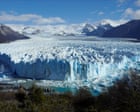
In the ever-evolving landscapes of our planet, two notable developments have emerged, highlighting the delicate equilibrium of Earth’s ecosystems. These stories, though hemispheres apart, underscore the intrinsic connection between human activities and environmental change, urging communities worldwide to reflect on sustainable futures.
One focal point of this global narrative is the renowned Perito Moreno Glacier, nestled in the stunning expanse of Santa Cruz province in Argentina’s Patagonia region. For decades, this glacier stood as a resilient symbol against the accelerating phenomenon of glacial retreat, which has rapidly transformed many icy landmarks worldwide. Scientists have long celebrated Perito Moreno for its stability, a badge of ecological honor amid warming global climates. However, recent observations suggest a pivotal shift in its state, with a marked loss of mass that has stirred conversations within the scientific community. Over the past seven years, Perito Moreno has receded by 1.92 square kilometers (or 0.74 square miles) while its ice thickness diminishes significantly, at rates of up to eight meters (about 26 feet) annually. Such changes invite reflection on the broader implications for local habitats and communities reliant on these icy reserves.
In parallel, a proactive environmental restoration effort is unfolding in China, where governmental initiatives aim to reshape the riverine landscapes of the Yangtze basin. With an endeavor to rejuvenate the region’s delicate ecosystems, the planned dismantling of 300 dams marks a bold step toward reviving natural water flows. This course of action is particularly focused on the Chishui River, one of the remaining sanctuaries for rare and endemic species in the upper reaches of the Yangtze. This river, stretching 400 kilometers, serves as a critical habitat that faces the pressures of human infrastructure. By removing these dams, Chinese efforts are designed not only to restore ecological balance but also to foster greater biodiversity, inviting these unique species a chance at thriving.
These stories are emblematic of a greater global movement to reconcile the needs of development with those of nature conservation. The Patagonia glacier’s recent retreat raises questions about the impacts of climate change and how natural landmarks serve as both indicators and casualties of shifting climatic patterns. Meanwhile, the Yangtze River project reflects a growing understanding of human intervention’s potential in positively steering ecological outcomes. Collectively, these developments encourage a dialogue on the multifaceted nature of environmental stewardship, reminding us that our actions today will inevitably shape the ecological narratives of tomorrow.
It is within these unfolding stories that we witness both challenges and opportunities. As countries, communities, and individuals engage with the complex interplay between human activities and natural phenomena, it is imperative to approach environmental issues with informed, deliberate strategies. The scientific community continues to play a pivotal role in providing insights and fostering understanding, hoping to guide effective policy measures and inspire collective action. In doing so, the world moves toward a future where development and conservation exist in harmonious balance, safeguarding the planet’s wonders for generations to come.
Source: {link}
